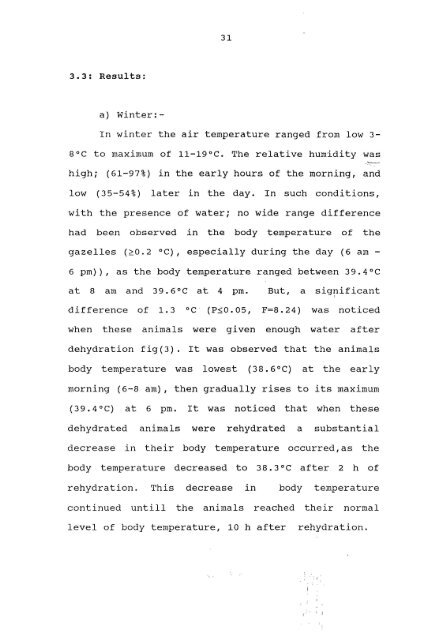- Page 4 and 5: IIIcontentspageAcknowledgementsAbst
- Page 6 and 7: v Chapter six:Etteot ot temperature
- Page 8 and 9: VII · (10) Var in mean PCV of gaze
- Page 10 and 11: IX F • (36) in mean urine urea of
- Page 12 and 13: GENERAL INTRODUCTIONIn most desert
- Page 14 and 15: 4 ~.2.~ G. subgutturosa san
- Page 16 and 17: 6 side of the Hijaz mountains. It i
- Page 18 and 19: .n :".,. ~,,';".'~. , '~ ' ~" ':
- Page 20 and 21: 10 valley places foothills, rocky o
- Page 22 and 23: 12 (1970a) stud the a temperature <
- Page 24 and 25: 15GENERAL MATERIALS AND METHODSwork
- Page 26 and 27: 17 METAL MESH- --~--- '/"~"" ~ 11
- Page 28 and 29: 19 . 2.1.3 Radio Telemetry System A
- Page 30 and 31: ; ,21 2.1.4 Temperature</st
- Page 32 and 33: 23 2.2.2 Blood and
- Page 34 and 35: 25 3.1Louw and(198
- Page 36 and 37: 27 In astudy of the skin tissue of
- Page 38 and 39: 29 3.2 Materials and</stron
- Page 42 and 43: 31 40Hy
- Page 44 and 45: 35 3.4. Discussion:It appears tha
- Page 46 and 47: 37 the difference was only O.8°C.T
- Page 48 and 49: 39 animals took alot of cold <stron
- Page 50 and 51: 41 4.1 Introduction:There are no st
- Page 52 and 53: 43 not an Is fed on Alfafa
- Page 54 and 55: 45 increased during dehydration , t
- Page 56 and 57: 47 4.2.2: Serum analysisBlood were
- Page 58 and 59: 49 Reaction sequence as follows:6 C
- Page 60 and 61: 51 4.3. Results:of the gazelle for
- Page 62 and 63: 53 1.35 x 10 9 /1 (29%). Within 24
- Page 64 and 65: 55 rehydration, the Hb level decrea
- Page 66 and 67: 57 HydrationDehydrationRehydrallon5
- Page 68 and 69: 59 165-HydrallonDehydra!lonRe hydra
- Page 70 and 71: L-__~____~______~______~______~____
- Page 72 and 73: 63 135 r--------------------,------
- Page 74 and 75: 65 level (303.5±4.6) was attained
- Page 76 and 77: 67 40Hydration Dehydrallon Rehydrat
- Page 78 and 79: 69 7 r---------------------~-------
- Page 80 and 81: 71 Dehydralion- 0.......Eg£:E::l
- Page 82 and 83: . 73gazelle (G. 1a) 8having an acce
- Page 84 and 85: 75 results are in agreement with th
- Page 86 and 87: 77 ison of the winter results with
- Page 88 and 89: 794.4.8:- Serum glucose :During t
- Page 90 and 91:
81 4.4.11:- Serum albumin:Dehydrati
- Page 92 and 93:
83 5.1. Introduction:There are no
- Page 94 and 95:
85 resulted in an increase in the u
- Page 96 and 97:
87 Na+, K+, cl-, urea in urine <str
- Page 98 and 99:
89 The values were obtained from th
- Page 100 and 101:
91 400 - RehydrallonHydrationDehydr
- Page 102 and 103:
93 350 ,------------------,--------
- Page 104 and 105:
95 400 iHydration Dehvdration Rehyd
- Page 106 and 107:
97 550r------------------.~----·--
- Page 108 and 109:
99 levels returned to normal after
- Page 110 and 111:
101comparison of the winter results
- Page 112 and 113:
103aldosterone, as it stimulates th
- Page 114 and 115:
105 during winter and</stro
- Page 116 and 117:
107 summer by 255% during dehydrati
- Page 118 and 119:
~.: j'... '.: ' . , .. .. ' .... .,
- Page 120 and 121:
111activities in the cooler periods
- Page 122 and 123:
~ .~ :; ' .. ,..; ~ : ' . ~'. , . ,
- Page 124 and 125:
1156.2.2: Dry Matter Intake (OMI):
- Page 126 and 127:
117 105°C (Mohamed, 1986) till the
- Page 128 and 129:
119 Hydration Dehydration Rehydrati
- Page 130 and 131:
121 650 .-----------------~--------
- Page 132 and 133:
123 3000 r----------------.--------
- Page 134 and 135:
12560 .-----------------~----------
- Page 136 and 137:
127 to the low food intake coupled
- Page 138 and 139:
129 attributed to the animals dem<s
- Page 140 and 141:
CHAprrER SEVEN GENERAL DISCUSSION
- Page 142 and 143:
133 The difference in body temperat
- Page 144 and 145:
135 function is controlled by two h
- Page 146 and 147:
137 ConclUB1- The shows that the Id
- Page 148 and 149:
139REFERENCESAbdelatif, A.M. <stron
- Page 150 and 151:
141 Unpubl. NCWCD,Gary, P,C' I , E.
- Page 152 and 153:
143 27-36.Ha if K. (1989). among th
- Page 154 and 155:
145 90A (2): 225-228.Musa, H.M. (19
- Page 156:
147 Williamson, D.T., Tatwany, H.,
















